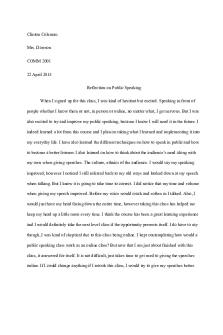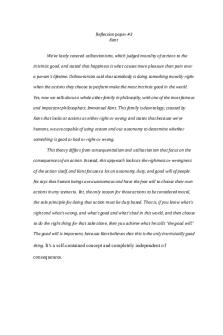HSCO 508 Reflection Paper Book Review PDF

| Title | HSCO 508 Reflection Paper Book Review |
|---|---|
| Course | Studies in Interpersonal Communication |
| Institution | Liberty University |
| Pages | 8 |
| File Size | 108 KB |
| File Type | |
| Total Downloads | 89 |
| Total Views | 130 |
Summary
Book Review...
Description
Running head: PRACTICAL BOOK REVIEW
Practical Book Review *** Liberty University
1
PRACTICAL BOOK REVIEW
2 Practical Book Review
Long-time pastor and author, James C. Petersen (2015), has put his practical techniques for anyone wanting to improve their listening skills in Why Don’t We Listen Better? Petersen describes over 30 listening techniques that will improve listening skills. If listening skills are improved then communication is also improved (Petersen, 2015). When people communicate effectively, then relationships can also improve, strengthen, and become more intimate (Petersen, 2015). He describes two levels of communication with the first being primarily exchanging information. The second level of communicating is where deep and satisfying relationships develop trust, feelings and intimacy. When communication becomes a challenge, Petersen (2015) describes this as Flat Brain Theory of Emotions. Those operating with a flat brain may damage relationships, hurt feelings, and lose intimacy with loved ones (Petersen, 2015). Response I gained several useful insights as a result of the listening techniques described by Petersen (2015). As a high D/C-type personality, I can have a tendency to steam-roll over more passive personalities in a conversation (Uniquely You, 2017). At times, I have an insatiable need to win or to be right in a discussion. This causes damage in my relationships leaving a trail of hurt feelings and unresolved arguments. Petersen (2015) suggests that this messy behavior is the result of my flat brain trying to gain power over the speaker. Thankfully, Petersen (2015) gives some important insight that I need to incorporate into my communication. Where I need to be vigilant is intentionally appreciating the other person’s words and opinions (Petersen, 2015). Ultimately, I want deeper relationships and not to claim victory over my opponent. The second insight that I found helpful was the sixth technique discussing how to decode the words in a conversation (Petersen, 2015). I have personally experienced painful
PRACTICAL BOOK REVIEW
3
conversations with loved ones in which the conversation quickly turns from bad to worse. Petersen (2015) easily explains that we speak through our own filters of experiences and at times miss the point we are tying to make. Our listeners then hear through their filters of experiences and many times misunderstand what was said (Petersen, 2015). The messiness of trying to decode what was said, meant, and heard takes some intentionality (Petersen, 2015). In a heated argument, I find it hard to quickly find the right words to describe what I mean and without the frustration showing up as accusations. Petersen, (2015) suggests when in a conversation that needs decoding, it is best to accurately reflect back what is heard with what was meant. This has been very valuable in several recent highly charged discussions with loved ones. Simply taking the additional few minutes to clarify seems to let some of the steam off of the conversation. The third valuable lesson that I learned was how to talk and listen. As a working mother with children, the dinner table can be a hot-plate of simmering thoughts all thrown out at once. At times, it is hard to hear over each other’s sharing of their days antics. While these types of conversations bring a smile, we may be damaging our level two communication with each other. Being a D-type, I can usually conquer the conversation and make myself heard above everyone (Uniquely You, 2017). Petersen (2015) describes how to listen without interrupting, taking charge, agreeing, disagreeing, defending, or advising. Sadly, as a D-type personality, I have advice and solutions for everyone, or so I once assumed (Uniquely You, 2017). I am no longer steam-rolling or taking charge of the conversations, I let my speaker have a safe place to say what they need. When my speaker is finished, I can reflect back their thoughts, and most importantly, wait my turn to speak. Critique
PRACTICAL BOOK REVIEW I greatly enjoyed Petersen’s (2015) book and suggest that it can be best used as a reference to return to over and over. I have a dominating personality and Petersen (2015) suggests biting the tongue to overcome my need to control, argue, or interrupt. There is hope as teeth marks in the tongue are the signs of a good listener (Petersen, 2015). The book includes a sample listening card that reminds me when it is my turn to talk and listen. The lesson on becoming a good listener was one of the most valuable in the book. I felt that Petersen’s (2015) suggestion for applying a number value to feelings and emotions is ridiculous. While this technique makes perfect sense in a hospital to rate a pain level, it seems a little dehumanizing in an emotional conversation. If I am trying to express hurt feelings, I do not want to be asked how to rate them. I would prefer that my listener reflects back, not with a game of number roulette. I feel that this technique seems very subjective and takes the humanness out of deep conversations. For example, when in the conversation is the number value established? Are the values always the same, even though my husband or kids may not have the same value? When I tell my kids that I love them before school, is that the same value as when I say it before bedtime or after a good scolding. I felt the number game is best left for the professionals in the birthing rooms and not in a conversation. There are three main ideas that Petersen (2015) discusses that are necessary for anyone in the helping business to learn. The first main idea is that effective listening is achieved when the person listening can accurately repeat or reflect back to the speaker what was said (Petersen, 2015). Petersen (2015) suggests that the listener must use the speaker’s same words, phrasing, and intonation. This helps to avoid any biased skewing or adding anything additional to the speaker’s message (Petersen, 2015). Interestingly, France & Weikel (2014) suggests not to use the speaker’s words, but to apply fresh words to repeating feedback to the listener. France &
4
PRACTICAL BOOK REVIEW
5
Weikel (2014) suggest that “repeating what the person said is not reflection (p. 22). Stewart (2012) entertains the idea that reflecting is an empathetic listening skill that involves four stages: paraphrasing, restating, paraphrasing again, and then finishing with a verifying question. The first stage is paraphrasing with fresh words and the second stage is restating with fresh words that include ideas and feelings (Stewart, 2012). The third stage is translating the paraphrase into the listener’s own verbiage and the final stage is ending with a question that allows the other person to verify the understanding or add more information (Stewart, 2012). The second idea that Petersen (2015) suggests is that of “nexting” as a technique that falls near the end of a relationship, when the speaker is calm, focused, and understood (Petersen, 2015). This allows the speaker to look the future and to their available options they have thought up (Petersen, 2015). Stewart (2012) suggests that nexting instills confidence, hope, and a future and is the most important skill of communication. By asking “what can I help to happen next?” reminds the client that their situation is not chiseled in stone (Stewart, 2012). This definition of nexting allows the speaker to contemplate their future options. France & Weikel (2014) discuss a three-step problem solving strategy. While nexting is not mentioned specifically, a combination of the second and third step may be similar. The second step is guiding the client towards considering their alternatives by helping clients brainstorm their possibilities (France & Weikel, 2014). The last step in the problem-solving strategy is to help clients come up with a realistic plan for their future (France & Weikel, 2014). All three authors strongly recommend that nexting is a form of encouragement that points to future possibilities and must be the client’s suggestion and not the helper’s plan. The third main idea that Petersen (2015) suggests for the listener or professional is to listen but never give advice. His reasoning is that advice is seldom used and rarely helps
PRACTICAL BOOK REVIEW
6
(Petersen, 2015). That was surprising to me when I first read that the role of a counselor or any listener was to allow the speaker to develop their own options. France & Weikel (2014) have the same opinion on avoiding advice except when the threat of harm is imminent (France & Weikel, 2014). Stewart (2012) also takes a firm stance on advice-giving, suggesting that it is a betrayal that leaves one person with control over another. Application Looking forward, I desire to first smooth over my strong personality traits while practicing effective listening. The numerous listening techniques by Petersen (2015) are easy to understand and implement. While reading through, I have already recognized and calmed several flat-brain tangos before developing into full-blown arguments. It has also been helpful to remember that the speaker owns the problem and it is not my problem to solve as the listener. At work, I have been confronted by friends that often discuss their situations. It is becoming easier to listen in lieu of trying to fix a situation. These practices in effective listening are quickly becoming habits that I will need as I enter into the human services realm. I have also been practicing the technique of acknowledging the speaker’s words and repeating them back. Although, repeating what I have heard feels very awkward and fake in most situations. My coworkers usually have a strange look on their faces when I implement a new strategy. In an attempt to deepen my interpersonal communication with loved-ones, I am focusing strongly on the speaking “withouts” (Petersen, 2015). This is an important strategy for deepening relationships and for strengthening communication. With a strong personality, I must be intentionally mindful of sharing without accusing, attacking, labeling, or judging the listener. Accusing, while speaking, simply puts the listener on the defensive and ready to interrupt and
PRACTICAL BOOK REVIEW
7
attack. This kind of tense situation can damage relationships that I am diligently trying to improve. In addition to strengthening my communication skills, I am also mindful of technique #26, horrific loss (Petersen, 2015). While I do not deal specifically with horrific loss, I do weekly speak with surviving spouses, in my line of work. When a survivor would approach my desk with a death of a loved-one, it was uncomfortable for me. This chapter was very helpful with the awkwardness that loss brings. I no longer give useless reassurances but instead simply listen first. Many times, the spouse simply wants to talk about their loss without interruption. In these situations, I just offer a sympathetic smile and genuinely listen until the words end. “The anguished need listening” and not information as they are not ready to listen (Petersen, 2015, p. 179). By listening, I am acknowledging my client’s feelings of loss and despair. While I do have to accomplish a few things with the survivor, I feel more confident that I can help them best by listening first and discussing options last. I have appreciated this section on loss and have implemented this listening technique several times, since reading it. Death is something that we all must be realistic about, I am thankful for the ideas on how to proceed without adding to another’s anguish.
PRACTICAL BOOK REVIEW
8 References
Petersen, J. C. (2015). Why don’t we listen better? Communicating and connecting in relationships (2nd ed.). Portland, OR: Petersen Publications. France, K. & Weikel, K. (2014). Helping skills for human service workers: Building relationships and encouraging productive change (3rd ed.). Springfield, IL: Charles C. Thomas Publisher Inc. Stewart, J. (2012). Bridges not walls: A book about interpersonal communication. New York, NY: McGraw Hill. Uniquely You (2017). Uniquely You, Inc. Leadership online profile professional expanded. Retrieved March 23, 2018 from https://uniquelyyou.org/profilesystem/report/331973...
Similar Free PDFs

Flashcards for HSCO 508
- 9 Pages

Mc Minn Book Review - HSCO 506 2
- 7 Pages

Reflection Paper
- 2 Pages

Reflection Paper
- 4 Pages

Reflection Paper
- 2 Pages

Reflection paper
- 3 Pages

Reflection paper for pino
- 2 Pages

Conflict Reflection Paper
- 8 Pages

Haudenosaunee reflection paper
- 3 Pages

Reflection paper rubric 05
- 1 Pages

Managment Reflection Paper
- 12 Pages

Reflection Paper chapter 5
- 1 Pages

Bev Reflection Paper 1
- 4 Pages

Paul Simon Reflection Paper
- 2 Pages
Popular Institutions
- Tinajero National High School - Annex
- Politeknik Caltex Riau
- Yokohama City University
- SGT University
- University of Al-Qadisiyah
- Divine Word College of Vigan
- Techniek College Rotterdam
- Universidade de Santiago
- Universiti Teknologi MARA Cawangan Johor Kampus Pasir Gudang
- Poltekkes Kemenkes Yogyakarta
- Baguio City National High School
- Colegio san marcos
- preparatoria uno
- Centro de Bachillerato Tecnológico Industrial y de Servicios No. 107
- Dalian Maritime University
- Quang Trung Secondary School
- Colegio Tecnológico en Informática
- Corporación Regional de Educación Superior
- Grupo CEDVA
- Dar Al Uloom University
- Centro de Estudios Preuniversitarios de la Universidad Nacional de Ingeniería
- 上智大学
- Aakash International School, Nuna Majara
- San Felipe Neri Catholic School
- Kang Chiao International School - New Taipei City
- Misamis Occidental National High School
- Institución Educativa Escuela Normal Juan Ladrilleros
- Kolehiyo ng Pantukan
- Batanes State College
- Instituto Continental
- Sekolah Menengah Kejuruan Kesehatan Kaltara (Tarakan)
- Colegio de La Inmaculada Concepcion - Cebu

